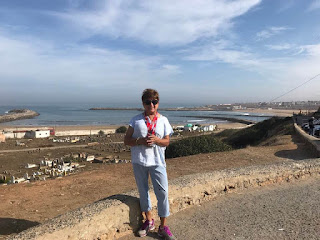The trip to Morocco came and went, and it was fabulous. The thing is, the minute our plane from Casablanca/Paris hit the ground in Detroit, really, the minute we landed, I got sick. A bout of the chills hit me hard as I gathered my luggage, and I was a goner. I had a fever and I shook all the way home from the Detroit airport to Sylvania.
I suffered not only from crummy flu symptoms but also from the thought I might not make it to New York. I prayed every day for the bug to go away. It was slow going, but it did get better by the day of departure. I felt good to go. Not 100%, but good to go.
 |
| Doris and Linda in NYC. |
 |
| Along the High Line, overlooking the city, art and gardens, interesting buildings along the way. "I'm fine kids!" |
I walked to the High Line under sunny skies, several city blocks up to 8th Avenue and 23rd Street. I climbed the steps, walked the 1.5 mile path of what used to be a railroad line, back and forth, slowly, taking it all in. I took lots of photos, enjoyed every moment, every scene, the gardens, the sculpture, the art, even the resistance items in an apartment window. It was a New York montage. I held up my sign, "Hi Kids, I'm fine," and I meant it.

But, by the time I made it back to Doris' apartment, things changed. My sinuses were plugged up, my chest congested, my voice dim, and I was coughing up a storm.
Geez. Not good, because Linda was scheduled for heart surgery in less than a week, and she could not afford to get sick. She was adamant and I was confused for a moment. My cough got worse on the spot. What should I do? What could I do? I decided to call friend Alice in NJ. We were scheduled to get together on Sunday; she was coming into the City and we were going to the Tenement Museum and maybe the Jewish Museum. Instead, I asked if I could come there now, today, this minute. I think I said I had a cold and had to leave Doris' apartment. Actually I don't remember what I said. Fortunately, Alice said yes.
 |
| Alice at home |
But I felt miserable, and I felt even worse about bringing my cold with me. When Alice started having a scratchy throat, I fell to my knees in prayer. Keep Alice healthy.
By the time I left to return home, Alice was coming down with the damn cold. It was small consolation that this bug is going around everywhere. I had made Alice sick.
It's a week later and I still have the cough. So does Alice. We commiserate on the phone and she is especially gracious, kind. I feel guilty. I thank the goddess for such a dear friend. "Please get her healthy right away."
I can think a little more about NYC now. There is something special about being there, the energy, the love. The theater. Ah yes. "To Kill a Mockingbird."
The heart of this "Mockingbird," however, written by Aaron Sorkin (how courageous!) does not belong to Atticus as much as to his undaunted, unrestrained, fearless daughter Scout, along with her brother Jem and their friend Dill. Scout's the narrator, the conscience, the one who asks questions, who voices the injustice, the outrage. Atticus plays off Scout, and Scout is relentless, unrestrained, uninhibited. I also like that Calpurnia, the Finches' housekeeper, has a stronger voice in this updated production, and she's not afraid to share it with Atticus. There's a kind of mutual respect between them that's refreshing.
In some ways I'm still in New York. Maybe it's the lingering cough. Mostly it's the lingering memories. They'll keep me going until my next trip to a city that never disappoints, always brings new discoveries, always beckons. When I was a Peace Corps Volunteer in Ukraine we used to say "if it's a bad experience, it's a good story." I feel that way about the quick turn around from Morocco to NYC. I'll remember the story more than the bad experience, and I won't stop believing that travel is the best teacher of all and worth whatever effort it takes.
Reviews:
https://www.rollingstone.com/culture/culture-features/to-kill-a-mockingbird-broadway-sorkin-review-travers-769996/
https://www.nytimes.com/2018/12/13/theater/to-kill-a-mockingbird-review-jeff-daniels.html













































